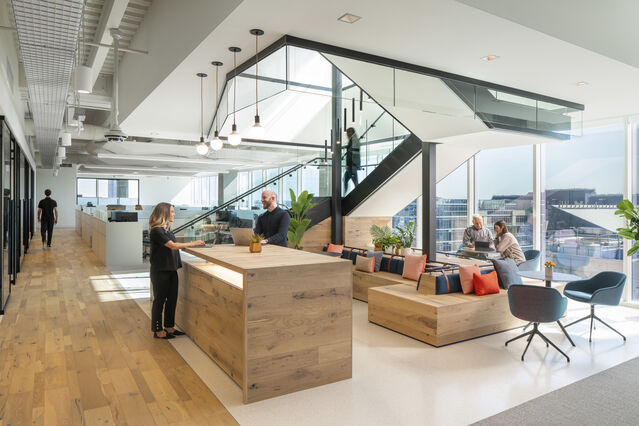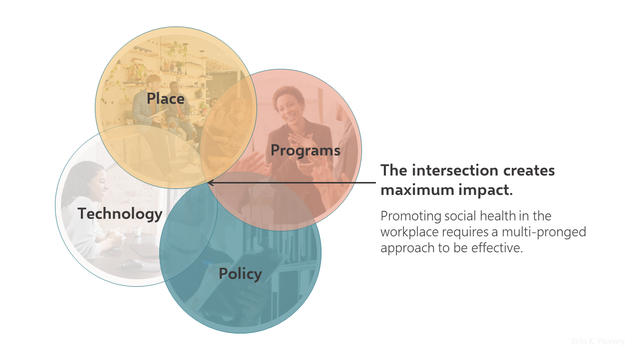Loneliness
3 Evidence-Based Strategies for More Connected Workplaces
How your office can be a catalyst for connection, retention, and engagement.
Posted June 2, 2022 Reviewed by Davia Sills
Key points
- Approximately 30 percent of your life is spent at work—and the relationships made there matter.
- Physical workplace environments are linked to employee loneliness, and place-based strategies can help foster connection.
- Successful approaches to foster connection integrate place, program, policy and technology interventions.

Long before COVID-19 sent many of us home to work, loneliness was a well-established problem at “epidemic” levels, as proclaimed by the U.S. Surgeon General, Dr. Vivek Murthy.
Pre-pandemic, 3 in 5 working adults (or 61 percent) in the U.S. reported feeling lonely some or all of the time.
Elevated loneliness is linked to decreased work satisfaction, productivity, and retention—costing employers billions of dollars—not to mention the cost to our collective health and well-being, something Dr. Julianne Holt-Lundstad and I covered in an earlier post.
Although loneliness can be at times misunderstood as a problem primarily for elderly people, those who have lost loved ones or are in a situation where they are on their own, research reveals that young adults have a pronounced increase in feelings of loneliness.
And there is reason to be concerned that full-time remote work may exacerbate loneliness for many people. “Our research showed that people who work from home extensively are certainly more likely to suffer from loneliness,” said environmental psychologist Nigel Oseland, Ph.D.
Oseland’s findings are supported by recent studies showing that full-time telework increased loneliness compared to in-office work by 67 percent and that remote workers reported loneliness as their largest struggle—tied with communication and collaboration problems.
Don’t get me wrong: I am not ignoring the benefits that remote work has provided, especially during such volatile times. Many of us, myself included, are grateful for reduced commutes and increased flexibility for juggling childcare—not to mention the sacred working in pajamas. Yet, full-time remote work on a global scale remains a social experiment, and one that research suggests may increase our collective sense of isolation and loneliness.
In a quest to understand how we can combat loneliness in the workplace, I recently sat down with Dr. Nigel Oseland on Shared Space to discuss the findings of his 2019 Loneliness Lab study on workplace environments and employee loneliness.
Oseland shared evidence-based strategies to foster workplace relationships that I synthesize for you here.

Design for workplace relationships.
“Even more so these days, where people are working from home, the office is about bringing people together.” — Dr. Nigel Oseland
In combating loneliness in the workplace, Oseland’s research focuses on fostering three types of relationships —social relationships (e.g., meeting new people, building friendships), business relationships (e.g., clients, partnership), and belonging. Each one contributes to collective workplace social capital and connectedness - and is supported with evidence-based design strategies.
1. Space to create and deepen relationships.
Social bonds are crucial for effective work. Social relationships build trust—and trust is essential for every business function. This includes building new relationships (e.g., new hires, colleagues, different practices) and maintaining and deepening relationships with existing colleagues. Evidence-based strategies include:
- Multifunctional spaces for social gatherings, team meetings, or chance encounters allow for people to naturally share space and thus have more opportunities to run into one another and strike up a conversation.
- Activity spaces can encourage connection over shared play, brain breaks, and hobbies.
- Shared coffee/tea spaces are best when strategically placed in highly-visually-connected areas of a space, where people naturally cross paths.
- Longer communal tables allow people to mingle and eat with one another.
2. Space to belong in a relationship.
A sense of belonging brings with it a feeling that you are a valued and accepted part of the group. In workplaces, this can be essential for fostering group cohesion and psychological safety. Evidence-based strategies include:
- Team boards that show personal photos and project work to be consistent visual and symbolic reminders of the shared values, goals, and experiences of the team.
- Multifunctional spaces for activities that infuse play into the workplace (e.g., games, puzzles) can offer a place for people to bond over a shared hobby, celebrate birthdays, or share a box of donuts or breakfast tacos.
- Outdoor spaces, like garden terraces or picnic areas, can provide a more casual atmosphere and allow team members to share sunlight and fresh air.
3. Space to foster business relationships.
Business relationships include those with both existing and potentially new business relationships, such as hosting clients. To support business relationships, provide a variety of comfortable meeting areas for both formal and informal conversations. Evidence-based strategies include:
- Private space to talk between a manager and employee navigating a difficult conversation or strategizing future hiring or investment decisions.
- Open, informal meeting areas provide opportunities to bring in groups of people. Have discussions allowing people to pin-up work for discussion.
- Drop-in tables for visitors help everyone to feel welcome, and there is always space to welcome them in and allow both visiting partners and practitioners of clients to feel comfortable.

Catalyzing workplace connection.
Throughout time, relationships have been an essential part of work for how they foster trust and create bonds we can later rely on for help.
Creating physical workplaces that foster connection is just one part of the equation. For these places to be truly effective catalysts of connection, they need supportive policies and cultural norms (e.g., flex work, lunch breaks, support), technology (e.g., integrated virtual collaboration), and programs (e.g., seasonal celebrations, employee recognition).
The future of the workplace is one that catalyzes connection to support the long-term growth of our organizations and the health and well-being of every generation.




